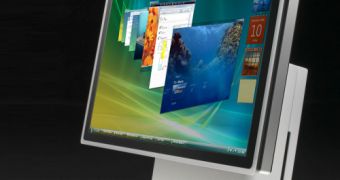Moving forward with Windows, and even past what is currently its proprietary operating system, Microsoft will have to deal with a crucial gambit ? evolution on a non-Windows path vs. perpetuating the platform's heritage for 1+ billion users. Not really much of a choice for the Redmond giant, which can't afford to go either way. Instead, the solution explored by the software company involves a compromise between moving onward, while at the same time remaining anchored in the past. Windows has climbed to the top of the operating system market, with a share of over 90%, on the ladder provided by an immense ecosystem of software solutions and hardware products designed to integrate seamlessly with the platform. In this context, the evolution of the platform, be it Windows 7, Windows 8 or Midori has to ensure an as close to 100% backward compatibility metric as possible.
The move from Windows XP to Windows Vista was nothing short of a wake-up call for Microsoft. Just the introduction of mitigations such as the User Account Control, PatchGuard (Kernel Patch Protection) and Mandatory Signed Drivers has generated a consistent level of incompatibility problems. But this is nothing compared to what an entirely new non-Windows OS, written from scratch in managed code, componentized and with fresh (long overdue) security boundaries will bring to the table. Midori is nothing but the promise of a world of pain for Microsoft, software developers, hardware manufacturers and the entire Windows install base.
Vista introduced compatibility mode in an effort to deliver a breath of fresh air for the applications designed specifically for older versions of Windows. Vista offered support for programs developed for Windows 95, Windows 98/ME, Windows NT 4.0 SP5, Windows 2000, Windows XP SP2 and even Windows Server 2003 SP1. The upcoming Windows 7, and even Windows 8, will follow Vista's footsteps. As far as Windows 7 is concerned, Microsoft has already confirmed a strong commitment to perpetuate the software and hardware compatibility level of Windows Vista.
"The Core Operating System Division (COSD) is the business unit responsible for the core OS platform, including development, program management and testing. The Application Experience within COSD is looking for an SDE/T to build and improve existing tools and databases that are the backbone of our group. The AppCompat group has the challenging work of testing windows for backward compatibility which involves executing, tracking and reporting tests of thousands of applications daily (both manually and automated tests). Recently our group has increased its responsibility by merging with the down-level OS testing, for which new infrastructure and tools are required," a member of the COSD team revealed earlier this year.
According to the COSD representative, the real mission is to "realize the challenging goal of keeping the next OS 100% backward compatible!" Now the next OS reference is rather abstract ? it could just mean Windows 7, or, in fact, it could go all the way to Midori, although the first variant is most likely. But this is not to say that Microsoft is not hammering away at the problem represented by ensuring compatibility with legacy software and hardware products for Midori. Virtualization in this case is the easy way out.
However, the inherent downside of using virtualization to ensure backward compatibility is that Windows itself would become a component of Midori. The non-Windows Midori would have to feature default virtualization capabilities (possibly even a hypervisor booting along itself) designed to run a very thin, core-Windows OS, something in the idea of MinWin, in order to ensure that legacy software and hardware are supported.
According to SDTimes, there are additional solutions explored by Microsoft when it comes to the race toward 100% backward compatibility. The first involves Midori code integrated into Windows via a device driver approach, a move that would essentially treat the entire Midori OS as a driver. There is also the possibility of a Windows Executive and a Midori Executive running in parallel, with the two operating systems fighting over resource allocation. The third idea, and the most drastic, is to bet big on Midori, and reduce Windows to an adjacent, virtualized OS that would only kick in when legacy software and hardware would need it.

 14 DAY TRIAL //
14 DAY TRIAL //